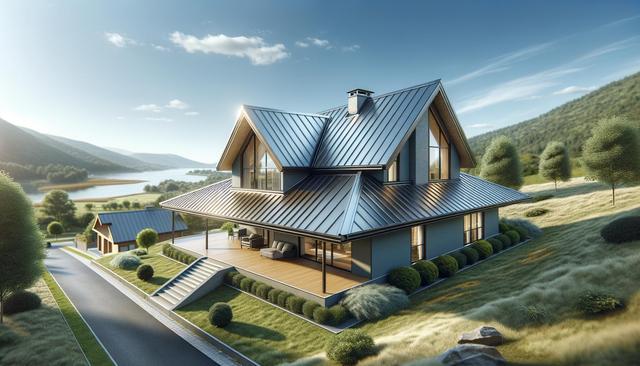Factors That Affect Metal Roofing Prices
Metal roofing prices are influenced by several variables, making it important to understand what contributes to the total cost. One of the primary factors is the type of metal used. Common materials include aluminum, steel, zinc, and copper, each with its own price range. Aluminum is generally more affordable, while copper tends to be more expensive due to its longevity and aesthetic appeal.
Other key elements that impact pricing include:
- Roof size and shape – Complex roof structures require more labor and materials.
- Geographic location – Prices can vary based on regional labor rates and material availability.
- Installation method – Whether the roof is being installed over an existing roof or replacing it entirely can affect labor costs.
- Accessories and custom work – Features such as skylights, chimneys, and ventilation systems may require additional flashing or detailing.
Understanding these components can help homeowners make informed decisions when budgeting for a metal roof installation.
Comparison of Metal Roofing Materials
Different metals offer distinct advantages, and their costs reflect their performance characteristics. Steel roofs, for instance, are durable and widely available, often making them a practical choice for many homes. Galvanized and galvalume steel are two common options within this category, each offering corrosion resistance and longevity.
Aluminum roofs are lightweight and resistant to saltwater corrosion, making them ideal for coastal regions. Zinc is known for its self-healing properties and long lifespan, though it comes with a higher initial cost. Copper, while among the most expensive, develops a patina over time that many homeowners find visually appealing.
Here’s a general overview of price ranges per square foot for common metal roof materials:
- Aluminum: $4 – $10
- Steel: $3 – $8
- Zinc: $6 – $12
- Copper: $10 – $20
These prices typically include materials only, so installation costs should be considered separately.
Labor and Installation Costs
Installation represents a significant portion of total metal roofing prices. Labor costs vary depending on the complexity of the job and the contractor’s expertise. On average, homeowners can expect to pay between $4 and $8 per square foot for installation alone.
Several installation methods influence labor intensity. For example, standing seam metal roofs involve interlocking panels that require precise workmanship, resulting in higher labor costs. Metal shingles, on the other hand, can be quicker to install depending on the design of the roof.
Factors that may increase installation expenses include:
- Removal of existing roofing material
- Repair or reinforcement of roof decking
- Installation of underlayment or insulation
- Custom fabrication or on-site adjustments
Hiring a qualified and experienced contractor is essential not only for safety but also for ensuring the longevity and performance of the roof.
Long-Term Value and Energy Efficiency
While metal roofing prices may appear high initially, the long-term benefits often justify the investment. Metal roofs can last 40 to 70 years depending on the material and maintenance, reducing the need for frequent replacement compared to asphalt shingles.
Additionally, metal roofs contribute to energy efficiency. Reflective coatings and pigments can help reduce heat absorption, lowering cooling costs during summer months. Some metal roofs are also compatible with solar panel installations, further enhancing energy savings.
Other long-term advantages include:
- Low maintenance requirements
- Resistance to fire, pests, and rot
- Improved resale value of the home
- Eco-friendliness, as most metal roofing is recyclable
Considering these benefits allows homeowners to view metal roofing prices from a value-based perspective rather than just the upfront cost.
Getting Accurate Quotes and Planning Your Budget
Because metal roofing prices vary widely, it’s essential to get multiple quotes from local contractors. A detailed estimate should include material costs, labor, and any additional expenses such as permits or debris removal. Make sure to ask about warranties, both for the materials and the workmanship, to protect your investment.
When planning your budget, consider potential upgrades that could enhance the performance of your roofing system. These might include improved insulation, high-performance coatings, or integrated gutter systems. While these features may increase the initial cost, they can lead to long-term savings and improved comfort.
Tips for getting accurate roofing quotes:
- Provide contractors with detailed information about your roof’s structure
- Request itemized breakdowns of all costs
- Check references and previous work before hiring
- Ensure the contractor is licensed and insured
Taking the time to plan thoroughly helps avoid unexpected expenses and ensures a smoother installation process.
Conclusion: Making a Smart Investment in Metal Roofing
Metal roofing prices reflect the quality, durability, and energy efficiency that these systems offer. While the initial cost may be higher than some alternatives, the long-term benefits make it a worthwhile investment for many homeowners. By understanding the factors that influence pricing and comparing quotes carefully, you can choose a roofing solution that meets your needs and fits your budget. Whether you’re prioritizing longevity, aesthetics, or energy savings, metal roofing provides a dependable and lasting option.


